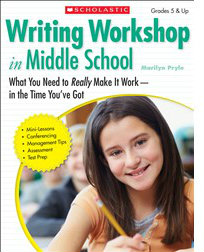Finding Time for Writing Workshop
Writing Workshop in Middle School: What You Need to Really Make It Work in the Time You’ve Got
By Marilyn Pryle
(Scholastic, 2012 – Learn more)
Reviewed by Nikki Melody
Have you ever wanted to start a Writing Workshop in your classroom but just couldn’t figure out how to fit it in along with everything else? I know I have spent countless hours planning, reading, and even attempting the workshop model in my own junior high classroom. With only 42 minutes per period, I couldn’t get in grammar, spelling, a writing lesson, and conferencing with students.

In 10 chapters, Pryle takes you step by step through how to organize your materials, train the students, carry off conferencing, and beyond. I knew right from the beginning that this book is what my writing lessons have been missing.
The author’s description of a typical classroom rang true — it’s one where I give instructions and the students write. I then spend hours and hours grading and making marks to help students improve their writing for next time — only to pass the papers back and have the students ignore my comments and focus only on the grade.
We would move on to the next writing assignment and the cycle would continue, with me becoming more frustrated by the lack of change in their writing and the students not truly engaged in the process of revision. Reading Pryle’s book brought me to my senses. I see what my classroom is missing.
Three things I loved about the book
As I was reading the book, I kept seeing three things that I loved.
1. Full of solutions. Pryle gives her explanation of what she did AND explains several other ways it could be done. Don’t have enough computers for each child? Here is a solution. Don’t have wall space for a lot of posters or folders? Here is a solution. While many writers explain how they did it and expect you to follow, Pryle knows not every classroom is the same.
2. Ideas about how to talk to kids. Pryle also gives readers suggestions on how to talk about difficult topics with kids. The topics she covers are ones that I have struggled to explain or never thought about from her perspective. She gives samples of conferences she had and tips on how to solve common problem students have.
My favorite tip was having students start the year by creating a ‘Topics for Writing’ list. I find that my students start the year with so many ideas and then the midyear slump hits and they have nothing to write about. By creating this list at the height of their enthusiasm, they can utilize it any time their brain just can’t seem to find something to write about. (Not that any of your middle school students ever have that problem I’m sure!)
3. She asks great questions of me. I also love the lists of questions Pryle asks to get me thinking about my own classroom. The questions are not just about the set-up of the desks but also how you will collect and organize materials. Will I set a minimum grade required so that kids know they can revise their work and earn back points? How will I handle conferencing? She even gives you space in the book to jot down your answers, making you think and reflect about the different questions she poses to the reader.
Each chapter explains how she accomplished the step, ideas on how to tweak it to fit your students, and often includes student notes describing how they liked the process. Ideas include how to differentiate for ELL students, students with IEP’s and those that are gifted writers. Pryle gives possible genre assignments and levels of difficulty — helping you differentiate for the different level of writers we all have in our classes.
Write with your students
Pryle stresses how important writing is, but more importantly how we (the teacher, the guide, the coach) portray our enthusiasm. She suggests that we do the assignments right along with the kids. Right from the beginning.
While this is something I’ve always done because I wanted my kids to see me write and revise, she explains that it also keeps us grounded in the assignment. How difficult was it to get started? Was the time allotted manageable? These are questions we need to remember during each assignment, so writing with the kids stays fresh.
Take it from me, as someone who never thought a writing workshop would work in my classroom, this book can convince you that you are wrong. I believe I now have the tools to make it work.
Pryle’s book aligns with the Common Core, covers the material I need, and most importantly, it’s what is best for kids. Her book includes all of the documents she references in the text — beginning to end.
If you have never set up a writer’s workshop, or you are having difficulty with the one you have established, I highly recommend this book. I think the over 30 sticky tabs I have left hanging from pages are proof enough that this book is filled with materials and ideas I will be using!
Nikki Melody is a 14-year veteran in the Rock Island-Milan School District in Rock Island, IL. Of those 14 years, 13 have been spent teaching language arts at Washington Junior High School. This year she will be the curriculum coach for the district. Her passions lie in continuing her education and helping others learn.




































